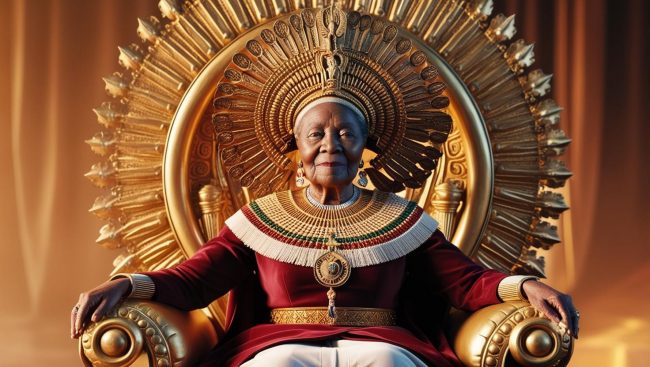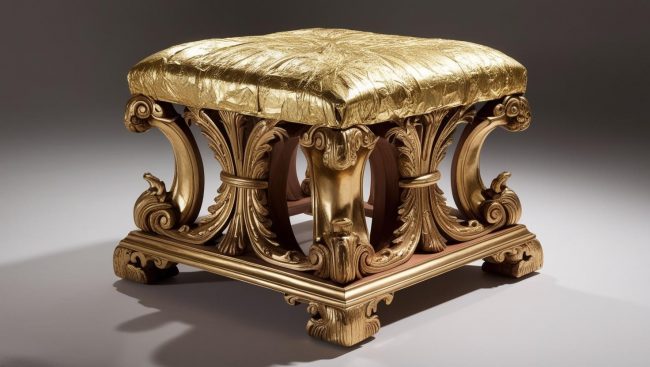Queens and Mothers of Afre Kh: Yaa Ashantewaa and the Golden Stool of Ashanti (Ghana)

The Ashanti Kingdom in Ghana West Africa was founded in the seventeenth century by King Osei Tutu I, with the help of his feared Priest Okomfo Anokye.
The myth is told that Okomfo Anokye conjured the famous Golden Stool from the sky and landed it on the lap of King Osei Tutu, the first King of the Ashantis. The Fetish Priest declared that the soul of the nation resided in the stool and the people must preserve and respect it. Ashantis believe that just as a man could not live when his soul is taken, so the Asante people would disappear from history if ever the Golden stool were taken away from them. Covered with pure gold, the Golden Stool is never allowed to touch the ground. When a new Ashanti King is installed, he is merely lowered and passed over the stools three times without touching it. Whenever the golden stool is taken out on special occasions, the Asantehene follows it.
The Ashanti Kingdom was rich in gold reserves, hence it grew in popularity and became the centre of the gold trade, which was largely responsible for the development of Ghana into a powerful, centralized kingdom. The peoples of West Africa had independently developed their gold mining techniques and began trading with people of other regions of Africa and later Europe as well. At the time of the Kingdom of Ghana, gold was traded for salt that came down from the Sahara desert. The Ghanaian kings controlled the gold that was mined in their kingdom and implemented a system of taxation for their people. Around 1054, the Almoravid rulers came south to conquer the Kingdom of Ghana and convert the people to Islam and it was another 400 years before the first Europeans arrived on the Gold Coast of Ghana. Arriving in 1471, the Portuguese encountered the Ashanti Kingdom’s control of the gold deposits. By 1482, the Portuguese had built the Castle of Elmina and several forts along the coastline, from where they traded knives, salt, mirrors, rum and guns for gold. News of the successful trading spread quickly, and eventually, English, Dutch, Danish, Prussian and Swedish traders arrived as well. Originally interested in trading in gold and spices, the Portuguese set up colonies on the uninhabited islands of São Tomé in the 16th century. There they found that these volcanic islands were ideal for growing sugar, a labour-intensive undertaking. Portuguese settlers were difficult to attract due to the heat, lack of infrastructure, and hard life. Hence, to cultivate the sugar the Portuguese began to seek the use of the more resilient African labourers. Soon, Elmina Castle on the Gold Coast, which was originally built with African labour by the Portuguese, became an important depot for slaves.
In 1821, the British government steadily began the expansion of their colonial power through the invasion of local kingdoms, particularly the Ashanti and Fante confederacies. Abolishing the African Company of Merchants, the British seized privately held lands along the coast, taking over the remaining interests of other European countries, and annexing the Danish Gold Coast in 1850 and the Dutch Gold Coast, including Fort Elmina, in 1871. The Ashanti people, who had controlled much of the territory of Ghana before the Europeans arrived started to resist the British and fought three wars with the British colonial invaders. Believing the Stool to be the rallying force of the Ashanti’s and the cause of the people’s continued resistance to colonial rule, the British Governor demanded the stool, which was also desired by the British for its legendary beauty and obvious value. Topped with a curved seat that is 46 cm high with a platform 61 cm wide and 30 cm deep, the Golden Stool’s entire surface is inlaid with gold. To protect the stool, Asantehene Prempeh 1 surrendered himself and was sent into exile in 1896. Now certain of victory, the British governor, Lord Hodgson, demanded that the Asanti turn over to the British the Golden Stool. Below is a record of Hodgson’s speech to the people of the Ashanti Kingdom:
“Your King Prempeh I is in exile and will not return to Ashanti. His power and authority will be taken over by the Representative of the Queen of Britain. The terms of the 1874 Peace Treaty of Formena, which required you to pay the costs of the 1874 war, have not been forgotten. You have to pay with interest the sum of £160,000 a year. Then there is the matter of the Golden Stool of Ashanti. The Queen is entitled to the stool; she must receive it. Where is the Golden Stool? I am the representative of the Paramount Power. Why have you relegated me to this ordinary chair? Why did you not take the opportunity of my coming to Kumasi to bring the Golden Stool for me to sit upon? However, you may be quite sure that though the Government has not received the Golden Stool at his hands it will rule over you with the same impartiality and fairness as if you had produced it.”
Being too barbaric to understand the significance of the stool, Hodgson had no idea that the suggestion that he a foreigner should sit on the Golden Stool, which is the symbol of the soul of the Ashanti people, would enrage the people. The effrontery of the British caused the Queen mother Yaa Asantewaa to gather an army that embarked on a covert mission to attack the British and retrieve their exiled king. Hodgson sent his deputy Captain C. H. Armitage into the surrounding villages to force the people to tell him where the Golden Stool was hidden and to bring it back. As he continued his expedition, Armitage found only children in the village of Bare, whose parents had gone hunting. Armitage ordered the children to be beaten and when the parents returned to defend the children, he had them bound and beaten, too. According to an eyewitness account:
“The white man asked the children where the Golden Stool was kept in Bare. The white man said he would beat the children if they did not bring their fathers from the bush. The children told the white man not to call their fathers. If he wanted to beat them, he should do it. The children knew the white men were coming for the Golden Stool. The children did not fear beating. The white soldiers began to bully and beat the children.”
The antics of the invaders caused the enraged populace to volunteer en-mass for the army under the leadership of the Queen Mother. As he continued his search for the stool, Captain Armitage’s force was ambushed. A small company of survivors escaped and retreated to the British offices in Kumasi where the Ashanti laid a long siege and blockade against the British. As supplies ran low and disease took its toll on the defenders, reinforcements arrived to liberate Kumasi and evacuate Hodgson and his family under the cover of Hausa warriors from the far northern tribes. The reinforcements invaded and plundered the villages, wiping out most of the population and capturing Yaa Ashantewaa and sent her into exile. The Ashanti confederacy was made a British protectorate in 1902. The Queen Mother remained in exile in Seychelles Island until her death in 1923. Contrary to British historical records, the British never found nor took possession of the Golden Stool, which is hung by bells and is not allowed to touch the ground. No king seats on the Golden Stool, which is kept in a secret location known only by the king, queen, heir apparent and a few trusted advisers. Replicas have been produced for ceremonial use.
The surviving members of the Ashanti Royal family returned to the country in the late 1920s after their release by the British. Notable among them was Nana Sir Agyeman Prempeh II, who ruled from 1931 until his death in 1970. Otumfuo Opoku Ware II, a professional surveyor born into the royal Oyoko clan, succeeded him. He was loved by all his subjects and contributed immensely to the development of the Ashanti nation. He died in 1999 after a 29-year reign. Being a matrilineal society, the current Asantehene or Ashanti King is the son of the Asantehemaa or Queen Mother by the name Otumfuo Osei Tutu II. Known in Private life as Nana Kwaku Dua, he was trained in Britain and has a private company based in Kumasi, the Ashanti Capital. This Great Ashanti King is also referred to among his people as “King Solomon” and has been awarded doctorate degrees by two universities in the United States of America.
The Golden Stool remains a mysterious symbol of the power and history of the Ashanti people.

This article was first published @ http://www.feelnubia.com/index.php/world-view/sage/113-the-golden-stool-of-ashanti.html
Read more about other Queens and Mothers: Queen Nana, Queen Makeda and Queen Nandi
